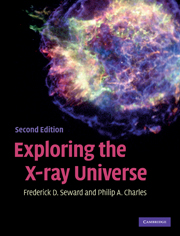Book contents
- Frontmatter
- Contents
- List of acronyms
- Foreword
- Chapter 1 Birth and childhood of X-ray astronomy
- Chapter 2 X-ray emission and interaction with matter
- Chapter 3 Tools and techniques
- Chapter 4 Solar system X-rays
- Chapter 5 X-ray absorption and scattering in the Interstellar Medium
- Chapter 6 Active stellar coronae
- Chapter 7 Early-type stars
- Chapter 8 Supernova explosions and their remnants
- Chapter 9 Neutron stars, pulsars, pulsar wind nebulae, and more supernova remnants
- Chapter 10 Cataclysmic variable stars
- Chapter 11 X-ray binaries
- Chapter 12 Black-hole X-ray binaries
- Chapter 13 Normal and starburst galaxies
- Chapter 14 Active galactic nuclei
- Chapter 15 Clusters of galaxies
- Chapter 16 The diffuse X-ray background
- Chapter 17 Gamma-ray bursts
- Index
- Plate section
Chapter 9 - Neutron stars, pulsars, pulsar wind nebulae, and more supernova remnants
Published online by Cambridge University Press: 05 June 2012
- Frontmatter
- Contents
- List of acronyms
- Foreword
- Chapter 1 Birth and childhood of X-ray astronomy
- Chapter 2 X-ray emission and interaction with matter
- Chapter 3 Tools and techniques
- Chapter 4 Solar system X-rays
- Chapter 5 X-ray absorption and scattering in the Interstellar Medium
- Chapter 6 Active stellar coronae
- Chapter 7 Early-type stars
- Chapter 8 Supernova explosions and their remnants
- Chapter 9 Neutron stars, pulsars, pulsar wind nebulae, and more supernova remnants
- Chapter 10 Cataclysmic variable stars
- Chapter 11 X-ray binaries
- Chapter 12 Black-hole X-ray binaries
- Chapter 13 Normal and starburst galaxies
- Chapter 14 Active galactic nuclei
- Chapter 15 Clusters of galaxies
- Chapter 16 The diffuse X-ray background
- Chapter 17 Gamma-ray bursts
- Index
- Plate section
Summary
Discovery and nature of neutron stars
Until the discovery of radio pulsars by Jocelyn Bell and Antony Hewish in 1967 (Hewish et al., 1968), neutron stars had existed only in the minds of theoretical physicists. First proposed as an end state of stellar evolution by Robert Oppenheimer and George Volkoff (1939), they are now accepted as the only explanation for radio pulsars. The discovery was serendipitous. No one had conjectured or even dreamed that this sort of signal might be generated.
Bell, then a student, had just spent months wiring antennas for a new radio telescope. In the course of testing, she noticed ‘a bit of scruff’ in the recorded signal. This ‘scruff’ was found to repeat, not every 24 hours (the solar day), but every 23 hours and 56 minutes (the sidereal day), showing that the source was anchored in the sky, not to the rotating Earth. Furthermore, when present, the signal was periodic with a remarkably stable period of 1.337 s. Thus CP 1919, the first of the radio pulsars, was discovered. The stable period could only be explained by rotation, and only a small object with strong gravity could rotate this fast without breaking up. A neutron star was the only reasonable explanation (Gold, 1968).
- Type
- Chapter
- Information
- Exploring the X-ray Universe , pp. 123 - 142Publisher: Cambridge University PressPrint publication year: 2010

